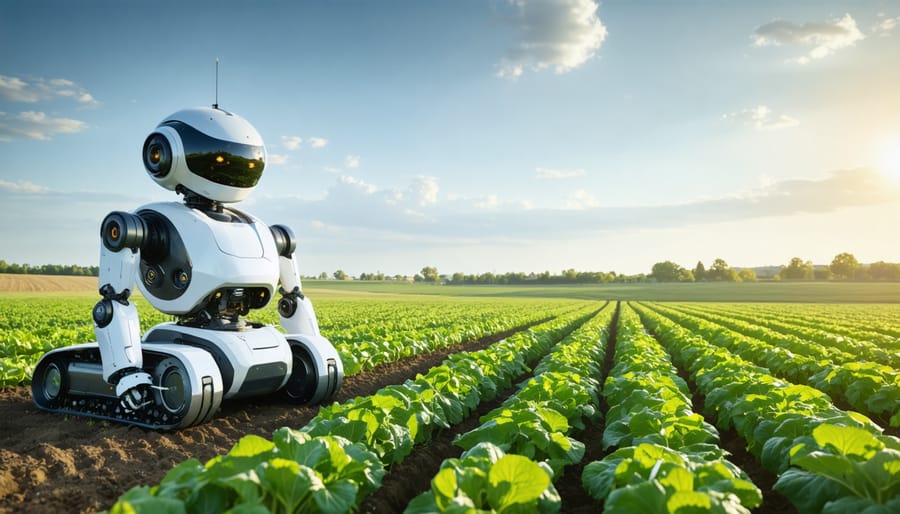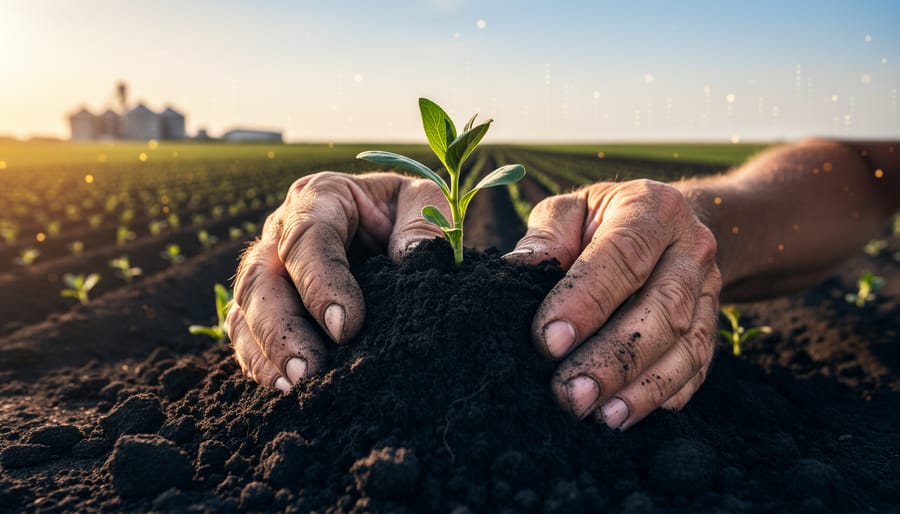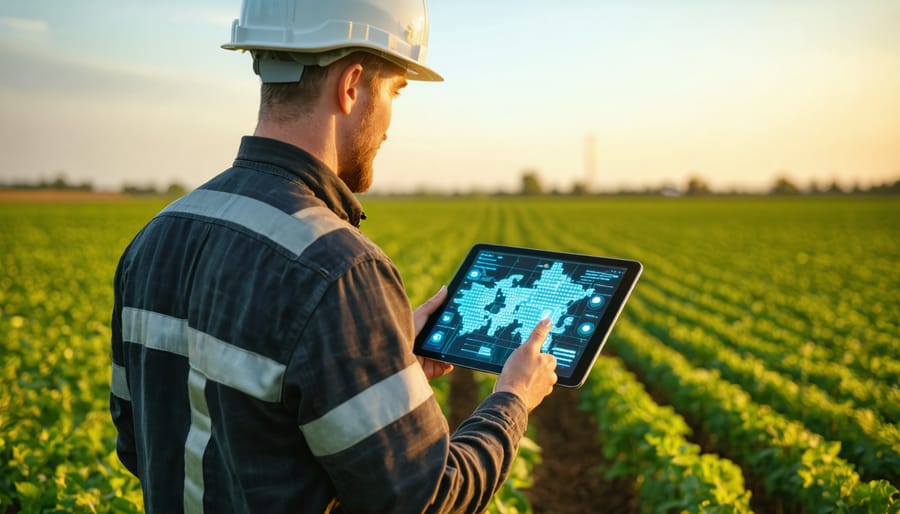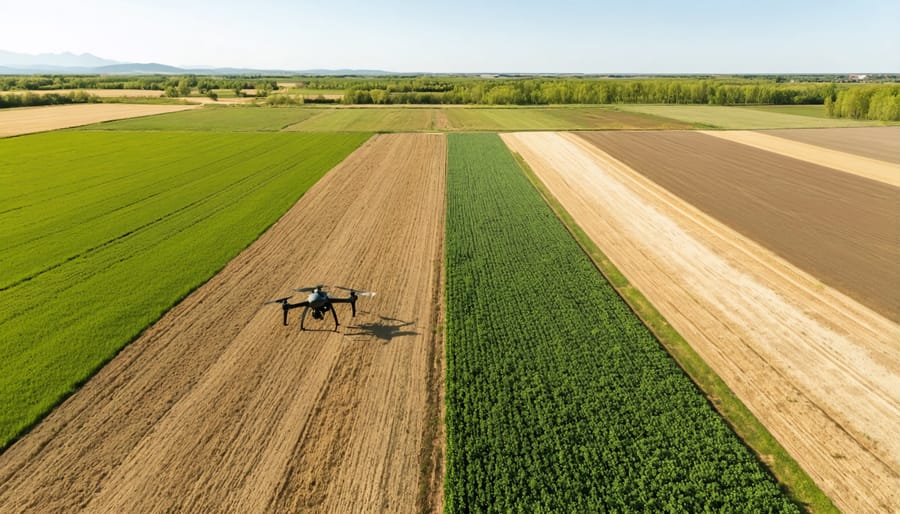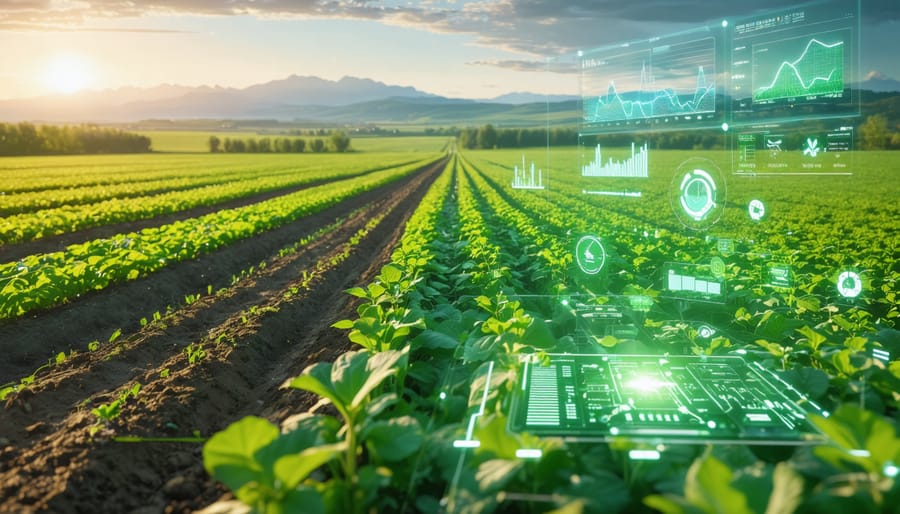Robotic automation is rapidly revolutionizing organic farming in Alberta and transforming traditional agricultural practices across Canada. Precision agriculture robots now navigate fields autonomously, reducing labor costs by 40% while maintaining strict organic certification requirements. These intelligent systems analyze soil conditions, detect pest infestations, and execute precise weed control operations with 95% accuracy, all while collecting valuable data that helps farmers make informed decisions. From automated seeders that optimize plant spacing to robotic harvesters that minimize crop damage, today’s agricultural technology offers practical solutions for the challenges facing Canadian organic farmers. As weather patterns become increasingly unpredictable and labor shortages continue to impact the agricultural sector, robotics provides a sustainable path forward, enabling farmers to maintain high-quality organic production while improving operational efficiency and reducing environmental impact.
The Rising Need for Robotics in Organic Agriculture
Labor Challenges in Alberta’s Organic Sector
Alberta’s organic farming sector faces unique labor challenges that are becoming increasingly pressing. Recent surveys indicate that over 65% of organic farms in the province struggle to find and retain qualified workers, particularly during peak harvest seasons. The specialized nature of organic farming, which often requires more manual labor and detailed attention to crop management, amplifies these difficulties.
The rising cost of labor in Alberta, coupled with the seasonal nature of farming work, creates additional pressure on organic operations. Many farmers report spending 20-30% more on labor costs compared to conventional farming operations due to the intensive hand-weeding and monitoring requirements of organic certification.
Young workers, traditionally a significant labor source, are increasingly choosing urban employment over agricultural work. This trend has left many organic farmers relying heavily on temporary foreign workers, which comes with its own set of challenges including housing requirements and administrative complexities.
These labor shortages often force organic farmers to scale back production or leave fields unharvested, impacting both farm profitability and local food security. The situation has prompted many Alberta organic farmers to explore automated solutions while maintaining their commitment to sustainable farming practices.
Environmental Benefits of Robotic Integration
Robotic integration in farming brings significant environmental advantages that align perfectly with Alberta’s commitment to sustainable agriculture. By precisely controlling input applications, agricultural robots reduce the overall use of pesticides and fertilizers by up to 95% compared to traditional broadcast methods. This targeted approach not only saves resources but also minimizes chemical runoff into local waterways.
Smart irrigation robots equipped with moisture sensors help farmers conserve water, typically achieving 30-50% reduction in water usage while maintaining optimal crop health. In the prairie regions, where water management is crucial, these systems have proven particularly valuable during dry seasons.
Autonomous electric vehicles and solar-powered robots significantly decrease the carbon footprint of farming operations. Many Alberta farmers report cutting their fuel consumption by half after implementing robotic systems for routine tasks like seeding and weeding.
Soil health also benefits from robotic integration. Lightweight autonomous machines reduce soil compaction compared to traditional heavy equipment, helping preserve soil structure and beneficial microorganisms. Additionally, precision weeding robots eliminate the need for broad-spectrum herbicides, supporting biodiversity and natural pest control systems in the field.
Key Robotic Technologies Transforming Organic Farms
Precision Weeding Robots
Precision weeding robots are revolutionizing organic farming across Alberta, offering a sustainable alternative to chemical herbicides. These autonomous machines use advanced cameras and artificial intelligence to distinguish between crops and unwanted plants, making them particularly valuable for organic operations where chemical solutions aren’t an option.
Recent field trials at the Olds College Smart Farm have demonstrated that these robots can reduce manual weeding labour by up to 85% while maintaining organic certification requirements. Farmers like Sarah Thompson from Drumheller report that their Farming Bot X-25 can cover approximately 2 hectares per day, operating effectively even in varied soil conditions common to the prairies.
These robots typically use a combination of technologies to eliminate weeds. Some employ precise mechanical tools that pull weeds or disturb their root systems, while others use targeted heat treatment or electrical discharge methods. The most advanced models can work around the clock in various weather conditions, though they perform best in dry soil.
For Alberta farmers considering this technology, initial costs range from $75,000 to $150,000, but many report breaking even within two to three growing seasons through labour savings and improved crop yields. Local agricultural equipment sharing programs are making these robots more accessible to smaller operations, with several farming cooperatives in Central Alberta already successfully implementing shared robot systems.
Battery life and maintenance requirements are improving with each new generation, with most current models operating for 8-10 hours on a single charge. Most importantly, these robots integrate well with existing organic certification protocols, providing detailed operation logs for compliance documentation.

Harvest Automation Systems
Modern harvest automation systems are revolutionizing how Canadian farmers gather their crops, offering solutions that address labour shortages while improving efficiency. These systems range from selective fruit pickers to root vegetable harvesters, each designed for specific crop types and growing conditions.
For orchards and berry farms, robotic harvesting arms equipped with advanced vision systems can identify ripe fruit and carefully pick them without causing damage. These machines use soft grippers and precise movements to handle delicate produce like strawberries and apples, working consistently through various light conditions and weather.
In grain farming, particularly relevant to Alberta’s vast wheat fields, autonomous combine harvesters are becoming increasingly common. These machines can operate 24/7 during peak harvest seasons, using GPS guidance and yield mapping to optimize their routes and cutting patterns.
For root vegetables, specialized robots use underground sensors and gentle lifting mechanisms to harvest carrots, potatoes, and other tubers. Local farmers report these systems reduce crop damage by up to 30% compared to traditional methods.
Greenhouse operations are also benefiting from mobile harvesting platforms that move along rows of tomatoes, peppers, and cucumbers. These systems can work alongside human pickers, helping to maintain consistent harvest schedules throughout the season.
What’s particularly exciting for our prairie farmers is how these systems can be adapted to work in varying field conditions, from the rich black soil of central Alberta to the more challenging terrain of the foothills.
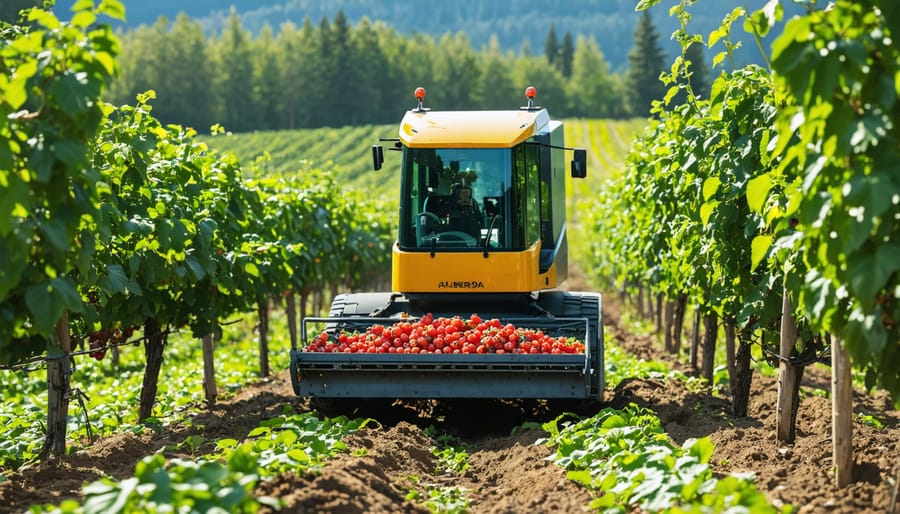
Soil Monitoring and Management Robots
Modern soil monitoring robots are revolutionizing how Alberta farmers maintain their soil health while meeting organic certification requirements. These autonomous systems combine advanced sensors with precision movement to deliver accurate, real-time soil data without disturbing the natural soil structure.
Leading the way are compact wheeled robots equipped with multi-spectral sensors that traverse fields collecting data on soil moisture, nutrient levels, and organic matter content. These robots work alongside smart soil monitoring techniques to provide detailed soil health maps that help farmers make informed decisions about irrigation and organic amendments.
Local farmer Sarah Thompson from Lethbridge reports a 30% reduction in water usage since implementing soil monitoring robots on her organic farm. “The robots detect moisture variations across my fields with incredible accuracy, allowing for targeted irrigation only where it’s needed,” she explains.
These robots also help maintain organic certification by documenting soil conditions and tracking the application of approved amendments. Many models now include automated sampling arms that can collect soil specimens for laboratory analysis, ensuring compliance with organic standards while reducing manual labour.
For Prairie farmers dealing with variable soil conditions, these robots offer particular value in identifying areas requiring specific attention, from addressing compaction issues to spotting potential erosion risks before they become problems.
Real Success Stories: Alberta Farmers Leading the Way
Small-Scale Implementation Success
The Gruber Family Farm in Lethbridge County demonstrates how small-scale organic farming success can be achieved through strategic robotics implementation. In 2021, Sarah and Michael Gruber invested in two autonomous weeding robots for their 40-hectare vegetable operation, marking a significant shift in their farming approach.
The Grubers started with a single robot managing their carrot beds, which reduced hand-weeding labour by 75% in the first season. Encouraged by these results, they added a second robot for their lettuce crops. The initial investment of $65,000 was recovered within 18 months through labour savings and increased crop yields.
“The robots have transformed how we manage our time,” says Sarah Gruber. “Instead of spending hours weeding, we can focus on crop planning and market development.” The farm’s productivity increased by 30%, while maintaining their organic certification requirements.
The robots work alongside their existing team, operating during off-peak hours and in various weather conditions. They use advanced sensors and GPS technology to navigate between crop rows with minimal soil compaction. The Grubers now share their experience with neighbouring farms, hosting monthly workshops to demonstrate how automation can support sustainable farming practices while preserving the hands-on nature of organic agriculture.
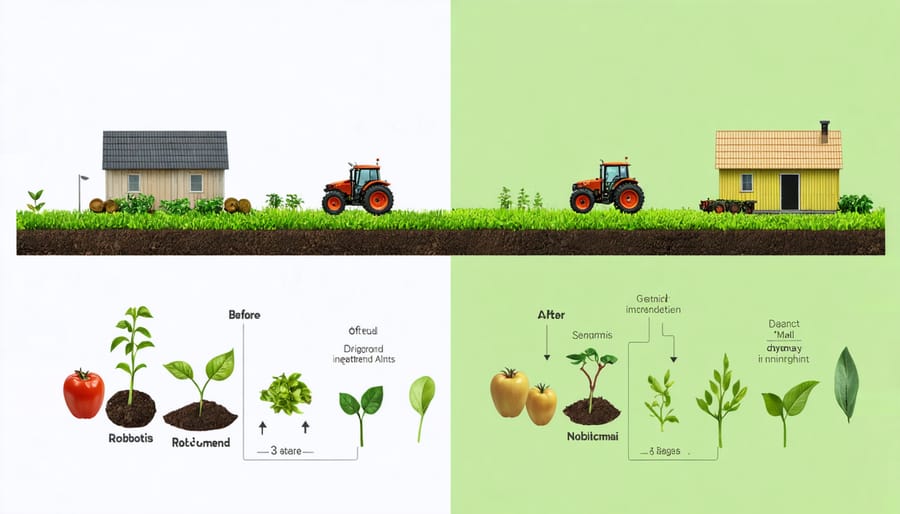
Large Operation Transformation
Sunrise Organic Farms in Lethbridge County demonstrates how larger operations can successfully integrate robotics into their farming practices. Owner Sarah Thompson, who manages 800 hectares of certified organic land, began her automation journey in 2019 with a modest investment in autonomous weed control systems.
“We started small, testing one robotic weeder on our carrot fields,” Thompson explains. “The results were so promising that we expanded our robotics program across our entire vegetable operation within two years.”
The farm now employs a fleet of four autonomous weeders, two robotic harvesters, and a drone-based crop monitoring system. This integration has reduced manual labour requirements by 40% while maintaining organic certification standards. More importantly, it’s improved precision in pest management and reduced crop damage during harvesting.
The transformation wasn’t without challenges. Thompson’s team needed three months of training to operate and maintain the new equipment effectively. The farm also had to upgrade its internet infrastructure to support the robots’ GPS and communication systems.
The investment has paid off significantly. Crop yields have increased by 25%, and operating costs have decreased by 30% after the initial two-year adjustment period. The farm now serves as a demonstration site for other Alberta organic producers interested in robotics integration, hosting regular field days and sharing their implementation strategies with the farming community.
Getting Started with Farm Robotics
Assessment and Planning
Before implementing robotics on your farm, a thorough assessment of your current operations and future needs is essential. Start by evaluating your farm’s specific challenges, such as labour shortages, productivity bottlenecks, or resource management issues. Document your seasonal workflows and identify areas where automation could provide the most significant impact.
Consider consulting with local agricultural technology specialists who understand Alberta’s unique farming conditions. They can help assess your soil types, crop patterns, and existing infrastructure to recommend suitable robotic solutions. Many farmers find success by integrating digital farm management tools to track and analyze their operation’s data before making major robotics investments.
Create a detailed implementation plan that includes:
– Budget considerations and potential ROI
– Timeline for gradual integration
– Training requirements for staff
– Infrastructure modifications needed
– Maintenance and support requirements
Start small with a pilot project in one area of your operation. This approach allows you to test the technology’s effectiveness while minimizing risk. Many successful Alberta farmers have found that beginning with autonomous monitoring systems or simple robotic weeders provides valuable learning experiences before expanding to more complex solutions.
Remember to factor in seasonal variations and extreme weather conditions common to our region when selecting robotic equipment. This ensures your investment can withstand local environmental challenges while delivering consistent performance throughout the growing season.
Available Support and Resources
Alberta farmers interested in implementing robotics technology can access various support programs and resources through provincial and federal initiatives. The Canadian Agricultural Partnership (CAP) offers grants of up to $500,000 for technology adoption, including automated farming systems and robotics solutions.
Alberta Innovates provides technical consulting and funding opportunities specifically for agricultural innovation projects. Their Smart Agriculture and Food Innovation program connects farmers with industry experts and potential technology partners.
For hands-on training and education, Olds College Smart Farm offers practical workshops and demonstration programs where farmers can experience robotic systems firsthand. The facility also provides ongoing technical support and consultation services for implementing new technologies.
The Agriculture Financial Services Corporation (AFSC) offers specialized loans and financial advisory services for farmers investing in agricultural technology. Their equipment financing programs can help offset the initial costs of robotic systems.
Local agricultural societies and farmer-led research groups across Alberta regularly organize knowledge-sharing events and peer support networks. These communities provide valuable insights from early adopters and create opportunities for collaborative learning.
For technical assistance, several robotics manufacturers have established service centers throughout the province, ensuring timely support and maintenance. Many also offer training programs and ongoing technical support as part of their service packages.
The Agriculture and Agri-Food Canada website maintains an updated database of available grants, programs, and resources specifically for agricultural technology adoption.
As we’ve explored throughout this article, robotics in farming represents a pivotal shift in Canadian agriculture, offering practical solutions to our most pressing challenges. From autonomous seeders to precision weeding robots, these technologies are helping Alberta farmers boost productivity while maintaining their commitment to sustainable practices. The success stories we’ve shared from local farms demonstrate that robotics isn’t just about automation – it’s about creating smarter, more efficient operations that benefit both farmers and the environment. By carefully considering your operation’s needs and starting with smaller, manageable implementations, you can join the growing community of Canadian farmers embracing this technology. Remember, sustainable agriculture’s future lies in finding the right balance between innovation and tradition, and robotics offers us the tools to achieve this balance. Let’s move forward together, adopting these technologies thoughtfully to ensure the continued strength and sustainability of Alberta’s agricultural sector.

